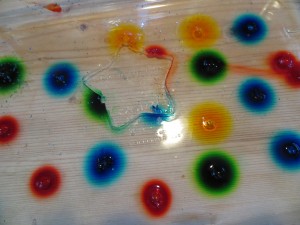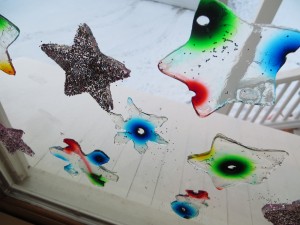Full Transparency
Our editorial transparency tool uses blockchain technology to permanently log all changes made to official releases after publication. However, this post is not an official release and therefore not tracked. Visit our learn more for more information.
Liz Heinecke, the Kitchen Pantry Scientist, and her children were growing restless during the “polar vortex” moving through the Midwest states. Liz, a former medical researcher, Earth Ambassador for NASA and educator knew there was a way to pass the dark, cold hours with science experiments that would keep her kids, and others, excited (and occupied) for hours. With the help of her children, they invented a science experiment that plays with floatation physics, diffusion and evaporation.
Liz asks, “what happens when food-coloring molecules move, or diffuse through gelatin, the substance that makes Jello jiggle?” To create the Kitchen Pantry Scientist’s window gellies, watch the video and follow these nine steps:
Step 1. Add 6 packs of plain, unflavored gelatin to 4 cups of boiling water. Stir until all the gelatin has dissolved and remove bubbles with a spoon.
Step 2. Allow gelatin to cool to a kid-safe temperature. Pour the liquid gelatin into two large pans or rimmed cookie sheets so it’s around 1-1.5 cm deep. It doesn’t have to be exact.
Step 3. Sprinkle glitter on the gelatin in one pan. Observe what happens to the glitter.
Step 4. Allow the gelatin to harden in both pans.
Step 5. In the pan with no glitter, use a straw to create holes in the gelatin, a few cm apart, scattered across the surface. Poke the straw straight into the gelatin and spin to remove. Using a toothpick, pull out the gelatin plug you’ve created.
Step 6. Add a drop of food coloring to each hole in the gelatin.
Step 7. Let the gelatin pans sit for 24 hours. Every so often, use a ruler to measure the circle of food coloring molecules as they diffuse (move) into the gelatin around them.
Step 8. Use cookie cutters to cut shapes from both the glitter and food coloring pans of gelatin. Carefully remove them from the pan with a spatula or your fingers, and use them to decorate a window.
Step 9. Observe your window gellies each day to see what happens when the water evaporates from the gelatin.
The Science Behind the Fun (adapted from KitchenPantryScientist.com)
Flotation: Why does glitter float on gelatin? An object’s density and its shape help determine its buoyancy, or whether it will float or sink. Density is an object’s mass (loosely defined as its weight) divided by its volume (how much space it takes up).
Diffusion: When the food coloring creates patterns and spreads throughout the gelatin, it is called diffusion. Diffusion occurs when molecules move from areas of high concentration, where there are lots of other similar molecules, to areas of low concentration, where there are fewer similar molecules. When the molecules are evenly spread throughout the space, it is called equilibrium. Temperature and vibrations can impact how quickly different substances, diffuse through water, air and soil.
Evaporation: What happens to the window gellies after they have been on the window a few days? The water will begin to evaporate – turning from a liquid into a gas that is released into the air. Your gellies will look like paper-thin “stained glass” art.
If you are looking for additional indoor science activities to keep your kids (and yourself) entertained during the winter months, add the KidScience app to your mobile device. Another great activity for kids to experiment with is the Crayola DigiTools™ Deluxe Pack. Your kids can strap on the 3-D glasses and create works of art on an iPad®. Want to add some friendly competition to your indoor activity? Design a race or obstacle course for the Orbotix Sphero 2 Robotic Gaming System to travel through.
For more Verizon Wireless news, subscribe via RSS feeds in the right rail.


